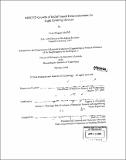| dc.contributor.advisor | Eugene A. Fitzgerald. | en_US |
| dc.contributor.author | McGill, Lisa Megan, 1975- | en_US |
| dc.contributor.other | Massachusetts Institute of Technology. Dept. of Materials Science and Engineering. | en_US |
| dc.date.accessioned | 2006-03-24T18:21:16Z | |
| dc.date.available | 2006-03-24T18:21:16Z | |
| dc.date.copyright | 2004 | en_US |
| dc.date.issued | 2004 | en_US |
| dc.identifier.uri | http://hdl.handle.net/1721.1/30119 | |
| dc.description | Thesis (Ph. D.)--Massachusetts Institute of Technology, Dept. of Materials Science and Engineering, 2004. | en_US |
| dc.description | Includes bibliographical references (p. 199-205). | en_US |
| dc.description.abstract | In this work, we examine fundamental materials processes in the growth of indium gallium phosphide (InGaP) via metalorganic chemical vapor deposition (MOCVD). In particular, we realize improvements in the epitaxial integration of high-quality InGaP device materials on non-standard platforms, such as GeSi graded buffers orSi substrates, and InGaP or indium aluminum gallium phosphide (InAlGaP) graded buffers on GaP substrates. We apply these improvements to the design and implementation of strained-InGaP quantum-well light emitting diodes (LEDs) operating in the yellow-green region of the visible spectrum. The innovative use of these traditional materials is intended to provide a solution for bright green solid-state light emitters. Initial modes of InGaP lattice-matched epitaxy on GeSi were studied. Three- dimensional growth was observed over a wide range of deposition temperatures and V/III ratios. Pre-growth thermal cycling in a H2 plus PH3 ambient led to a large increase in surface roughness and the formation of surface mesas. Thermodynamic simulations suggest that these mesas may be P clusters or GeP solid complexes. They may also be surface oxides formed in conjunction with water vapor in the deposition chamber. Such surface degradation prior to the initiation of epitaxy is unfavorable for monolayer growth. The development and evolution of defect microstructures in relaxed, compositionally graded InGaP buffers deposited on GaP were examined. In particular, the properties of branch defects in InGaP graded buffers were examined for a large number of growth and annealing conditions. | en_US |
| dc.description.abstract | (cont.) These studies confirm that branch defect formation is driven by surface, not bulk, processes. Branch defects in the bulk arise from surface features that are metastably "frozen" in place by subsequent deposition and propagate through the thickness of the sample. We conclude that branch defects comprise a local compositional fluctuation resulting from the clustering of In atoms. This identification is supported by the suppression of branch defect formation under conditions of reduced adatom mobility, including low growth temperature and high V/III ratio. In addition, we demonstrate that dislocations gliding in the [110] direction are -preferentially blocked by strain fields arising from nearly-[110]-oriented branch defects. This is further evidence for the link between branch defects and In clustering. A relaxed InAlGaP graded buffer platform was utilized in the design and fabrication of a novel strained-InGaP quantum-well epitaxial-transparent-substrate LED (ETS-LED). The best devices exhibited yellow-green emission with a primary wavelength of 590 nm and a secondary wavelength of 560 nm. These devices had [rho]TD = 7 x 106 cm2 and an In 0.32 Ga 0.68 P quantum well active region, and operated at 0.18 [mu]W per facet at 20 mA, corresponding to a luminous efficacy of approximately 0.01 1m/W. Transmission electron diffraction indicates that the observed spectral lineshape is the result of emission from ordered and disordered domains in the quantum well. Devices with [rho]TD = 5 x 107 cm-2 and an In 0.32 Ga 0.68P ... | en_US |
| dc.description.statementofresponsibility | by Lisa Megan McGill. | en_US |
| dc.format.extent | 205 p. | en_US |
| dc.format.extent | 9286017 bytes | |
| dc.format.extent | 9285825 bytes | |
| dc.format.mimetype | application/pdf | |
| dc.format.mimetype | application/pdf | |
| dc.language.iso | eng | en_US |
| dc.publisher | Massachusetts Institute of Technology | en_US |
| dc.rights | M.I.T. theses are protected by copyright. They may be viewed from this source for any purpose, but reproduction or distribution in any format is prohibited without written permission. See provided URL for inquiries about permission. | en_US |
| dc.rights.uri | http://dspace.mit.edu/handle/1721.1/7582 | |
| dc.subject | Materials Science and Engineering. | en_US |
| dc.title | MOCVD growth of In GaP-based heterostructures for light emitting devices | en_US |
| dc.title.alternative | Metalorganic chemical vapor deposition growth of In GaP-based heterostructures for light emitting devices | en_US |
| dc.type | Thesis | en_US |
| dc.description.degree | Ph.D. | en_US |
| dc.contributor.department | Massachusetts Institute of Technology. Department of Materials Science and Engineering | |
| dc.identifier.oclc | 55858260 | en_US |
